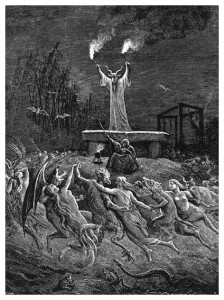 Joseph Laycock of Religion Dispatches talks here to (and about) “Lucien Greaves”, who is, apparently, the man behind the piece of Satanic kitsch now planned for Oklahoma.
Joseph Laycock of Religion Dispatches talks here to (and about) “Lucien Greaves”, who is, apparently, the man behind the piece of Satanic kitsch now planned for Oklahoma.
Disappointingly, Greaves turns out to be a rather wishy-washy devil worshiper:
In 2005, Greaves had lunch with Peter H. Gilmore, high priest of the Church of Satan founded by Anton LaVey. Greaves felt that a cultural shift had occurred with the rise of the New Atheist movement, led by the likes of Richard Dawkins and Sam Harris, and that Satanists should participate in this new conversation about religion in the public sphere. As a cognitive scientist, he was suspicious of Dawkins’ claims that humanity can live without religion since he felt that humans are “hard wired” to interpret the world through a rich language of symbol, narrative, and ritual. So Greaves imagined Satanism as a religion that could combine Dawkins’ aversion to supernaturalism with powerful and compelling symbols—what might be called a “sacralized” atheism.
Greaves is dead right about the hard wiring, but somehow I cannot see old Nick as an entirely plausible object of veneration to be used in the rites of—no God help us—“sacralized” atheism. There’s just too much baggage there, souls in torment, fire, brimstone, apocalypse, Rosemary’s Baby, you know how it goes.
Read on further, and it turns out that Greaves is using his supposedly Satanic agenda to make a decidedly political point.
Greaves was eventually approached by The Satanic Temple, a group that shared his political goals and saw Satanism as a “poison pill” that could be used to check the erosion of the establishment clause by reminding the public that privileges afforded to Christians could also be afforded to Satanists….
Future plans involve legally ordaining ministers and using the free exercise clause to claim privileges for Satanists. Satanic ministers could, for example, illegally marry a gay couple and then, when the state refuses to recognize the marriage, claim that their free exercise rights have been violated.
So satire then?
Laycock continues:
To gain any legal traction, Greaves will have to demonstrate that he is sincere about Satanism and that these projects are more than just pranks, which may prove difficult for a newly formed group that denies any belief in the supernatural. His opponents understand this too. Greaves described how, before his work with the Satanic Temple, advocates of SRA produced conspiracy theories about him, claiming that only someone secretly connected to criminal Satanism would challenge their claims. But now that he’s demanded Constitutional rights for Satanists, his detractors have reversed course. In an interview with Fox News he was repeatedly challenged as not being a real Satanist. Even the Church of Satan has joined the queue to call Greaves a phony Satanist.
In an article for Time, the Church’s High Priestess Magistra Peggy Nadramia, claimed that Greaves is not an authentic Satanist and merely “riding the coattails” of the Church of Satan, adding that “The Church of Satan is decidedly uninterested in politics.”
Greaves dismissed these attacks, asserting that preserving their status as the monolithic embodiment of Satanism appears to be the Church’s only goal. For his own part, Greaves claims he has no interest in being the public face of Satanism and that struggles over leadership are at odds with Satanism’s anti-authoritarian philosophy.
Satanism has an “anti-authoritarian” philosophy? That’s not how it looked in The Omen.
The conclusion to this piece though is well worth pondering
Greaves feels that a community centered around Satan—not as a literal entity but a potent metaphor for values that he holds sacred—is more than just a philosophy and should enjoy the same Constitutional protections afforded to religion. If the Satanic Temple’s campaign has any traction it will force a public discussion not simply on the Constitutional issues surrounding religion, but on the perennial problem of what religion is.
Once-in a saner era-there would have been no problem at all about defining what a ‘proper’ religion was. Well, not too much, anyway. But now…
To repeat the point that I made the other day, those pursuing a highly expansive definition of “religious freedom” in today’s very changed America may well not appreciate where such arguments may lead.

It looks like there are a bunch of kinds of Satanism, and by stunning coincidence, in every version Satan always agrees with the believer. Which sort of reminds me of a lot of religions.
I’ve never heard anyone say, “I have such and such core moral belief, but I know that God actually teaches the opposite.”
Some Wiccans are similar — they don’t believe in any literal Goddess but practice religion-like rites to scratch their religious itches.
Maybe this argument is a sign of a saner era…where religion is defined not by a belief in invisible gods or invisible souls, but by the real, palpable, human instincts it satisfies.